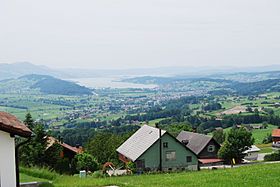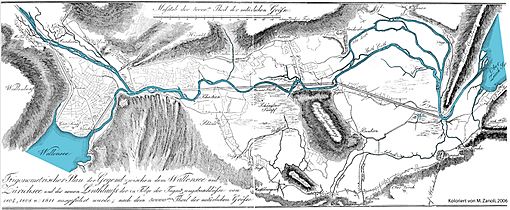Battle of Linth River facts for kids
Quick facts for kids Battle of Linth River |
|||||||
|---|---|---|---|---|---|---|---|
| Part of the Italian and Swiss expedition during the War of the Second Coalition | |||||||
 The Linth River curves around the base of the Buchberg at left center before flowing into Lake Zurich. |
|||||||
|
|||||||
| Belligerents | |||||||
| Commanders and leaders | |||||||
| Strength | |||||||
|
Total: 14,500
|
Total: 19,000
|
||||||
| Casualties and losses | |||||||
|
Total: 1,100
|
Total: 6,500, 32 guns, 4 flags
|
||||||
The Battle of Linth River took place on September 25–26, 1799, in Switzerland. It was a key battle during the War of the Second Coalition, a major conflict in Europe. In this battle, a French army division led by General Jean-de-Dieu Soult fought against Austrian, Russian, and Swiss rebel soldiers. These Allied forces were commanded by General Friedrich Freiherr von Hotze.
General Soult's troops successfully crossed the Linth River, which flows between Lake Zurich and the Walensee. General Hotze was killed early in the battle, which caused confusion among the Allied defenders. They were defeated and had to retreat, leaving behind important supplies meant for another Allied army.
On the same day, a larger French army, called the Army of Helvetia and led by General André Masséna, won the Second Battle of Zurich against a Russian army. Both the defeated Russians and Hotze's remaining soldiers had to withdraw north of the Rhine River. These French victories happened because the Allied armies were not working together well. Their plan was to unite different armies, but the timing was off. This allowed the French to defeat them one by one.
Contents
Background to the Battle
Allied War Plans
In the summer of 1799, the Allied countries made a big mistake in their war plans. William Grenville, 1st Baron Grenville, a British leader, created a plan. He suggested that 45,000 Russian soldiers under General Alexander Korsakov would join 20,000 Russian soldiers under General Alexander Suvorov in Switzerland. Suvorov would then lead this combined army to push the French out of western Switzerland.
After that, Suvorov's army would move into France. Meanwhile, Austrian General Archduke Charles, Duke of Teschen would move his army north into Germany. He would leave 18,000 Austrian soldiers under General Hotze to help the Russians in Switzerland. Another plan involved British and Russian forces invading the Batavian Republic (modern-day Netherlands).
This plan was approved by Emperor Paul I of Russia and Emperor Francis II of Austria. However, problems quickly appeared. General Charles worried about the Russian troops. General Korsakov was surprised to learn his army had only 28,000 soldiers, not the 45,000 the plan assumed. Also, only 2,000 Swiss soldiers joined the Allies, far fewer than hoped.
General Hotze also underestimated the French army's strength, thinking they had 60,000 troops when they actually had 76,000. On August 15, 1799, Suvorov won a battle in Italy. He wanted to chase the French, but the Austrians told him to go to Switzerland instead. The Austrian emperor insisted Suvorov march immediately.
In the end, the Allied plan failed because of bad timing. General Charles left Switzerland too early, and General Suvorov arrived too late. This left Korsakov and Hotze in a dangerous position to face the strong French army led by General Masséna.
Troop Positions Before the Battle
After General Charles's army left, the Allied troops in Switzerland were spread out. General Korsakov's 26,000 Russian soldiers held a line from Zürich to the Rhine River. General Hotze personally led 8,000 troops defending the Linth River area. Other Austrian forces were further east and south.
General Masséna's French army was also spread out. His main force of 34,000 soldiers faced Korsakov near Zürich. General Soult's 12,700 soldiers faced Hotze along the Linth River. General Gabriel Jean Joseph Molitor's troops, part of Soult's command, defended the upper Linth.
The area held by Soult and Molitor was a bit exposed, like a bulge in the French lines. The Allies planned to attack this area. General Linkin's Austrians would cross mountains to support Hotze. General Franz Jellacic would move along the Walensee to attack the French from the side. Hotze would then break through the French lines on the Linth and advance towards Zürich. Once Hotze was close, Korsakov would attack Masséna's main army.
Suvorov chose the Gotthard Pass to enter Switzerland, even though it was a very difficult route for wagons. He had some mountain cannons, but most of his artillery had to go a different, longer way.
Masséna found out that Korsakov planned to attack him on September 26. So, Masséna decided to attack Korsakov first, on September 25. The French commander didn't know that Suvorov was already on his way from Italy. On September 25, the Second Battle of Zurich began. The French crossed the Limmat River and pushed the Russians back into Zürich. The next day, Korsakov's army broke out and retreated north, losing many wagons and cannons. Meanwhile, Suvorov's army had already defeated some French troops at the Gotthard Pass on September 24.
The Battle of Linth River
Crossing the Linth River
General Soult's division had two brigades, led by Generals Joseph Antoine Marie Mainoni and Anne Gilbert de Laval. General Molitor's brigade was also part of this force. Facing them were General Petrasch's Austrians and General Alexander of Württemberg's forces, along with some Russian and Swiss troops.
For ten days before the attack, General Soult disguised himself as a regular soldier. He spent an hour each day on guard duty at different French outposts, carefully watching the Austrian positions. The Austrians would shoot at soldiers who got too close to the river, but they left sentries alone.
Soult planned to cross the Linth River at two places: Bilten and Grynau. He also gathered some boats to challenge the small Austrian fleet on Lake Zurich. A cannon battery was built across from Rapperswil to stop the Austrian boats from moving freely on the lake.
On the night of September 24, 2,000 French soldiers built a 300-yard-long path through the marsh at Bilten using bundles of sticks (called fascines) and wooden beams. This allowed them to bring up bridging materials. At 2:30 AM, 150 French swimmers, led by General Jean-Pierre Dellard, slipped into the Linth River. They carried pistols, lances, and sabers. Ten drummers and four buglers were also with them.
Some Austrian guards were quietly dealt with. The French group then splashed through the marsh to surprise an Austrian outpost. Dellard gave the signal for the main French troops to cross the river in boats and on rafts. Some French soldiers, dressed in Austrian uniforms, went ahead, shouting in German, "Save yourselves! We are betrayed!" This caused confusion among the Austrian defenders.
A thick fog helped Soult's attack. The French also successfully crossed at Grynau Castle. Boats were used to ferry some soldiers across Lake Zurich to Schmerikon. General Hotze was woken up by cannon fire at 4:00 AM. He rode to Schänis, where his troops were fighting hard. Hearing about trouble at Weesen, he rode towards the Walensee to check. On the way, Hotze rode into two French battalions in a forest and was shot and killed, along with his chief of staff.
General Petrasch took command, but he was too slow in bringing up reinforcements. By the time they arrived, the French cannons were already across the river and pushed back the Austrian counterattacks. The fighting continued until a final Austrian attack failed, and many soldiers were captured. Meanwhile, Soult's makeshift fleet attacked Rapperswil. Petrasch ordered the Russians and Swiss to retreat, while the Austrians withdrew to other towns.
Part of Petrasch's division was trapped at Weesen and had to surrender. The French claimed to have captured 3,500 men, 25 cannons, four flags, and the Austrian boats. The French lost about 1,100 soldiers killed, wounded, or missing. The Allies lost 3,500 prisoners, 20 cannons, and other supplies. The French also captured a large supply store at Rapperswil, which was meant for Suvorov's army.
Fighting at Mollis and Glarus
On September 24, General Jellacic marched from Sargans to Mollis, along the south shore of the Walensee. He attacked General Molitor's brigade the next day. This was the same day Soult and Hotze were fighting on the lower Linth. Jellacic attacked Molitor's forces from behind, but he couldn't push them out of their strong positions along the upper Linth.
Molitor's force included soldiers from the 84th and 76th Line Infantry regiments. Jellacic commanded several Austrian battalions. Molitor counterattacked on September 26 after hearing about Soult's victory. Jellacic began to retreat at 2:00 PM towards Walenstadt and then further back to Maienfeld. He lost 500 men captured.
General Linkin's force crossed several mountain passes on September 25. When his troops came down into the Sernftal valley, they surprised two French battalions. Linkin captured 1,300 French soldiers at Wichlen. On September 26, Linkin's force took Schwanden and pushed the French back beyond Glarus. Soult sent more troops to Molitor as backup.
Molitor attacked on September 27 but was pushed back. Linkin counterattacked later that day but couldn't capture Glarus. The next day, Linkin received a confusing message that Suvorov was heading west. On September 29, Molitor attacked again, but the Austrians held their ground. Then, Linkin received another message, possibly from a spy, falsely saying that a key valley was in French hands. Since he hadn't heard from Hotze or Suvorov, Linkin ordered a retreat. His troops went back over the mountains to the Rhine valley. The French captured 300 Austrians.
Ironically, Molitor couldn't chase Linkin because he received a report of another enemy group coming from a different pass into his rear. This was General Auffenberg's brigade, which was the advance part of Suvorov's army. Molitor's troops quickly moved to fight Auffenberg.
On September 26, Masséna learned that Suvorov's army had captured the Gotthard Pass and was heading towards Altdorf. He sent troops south to Schwyz and ordered Soult's division to block the Linth valley. The French were now in a position to trap Suvorov's army between Schwyz and Glarus.





